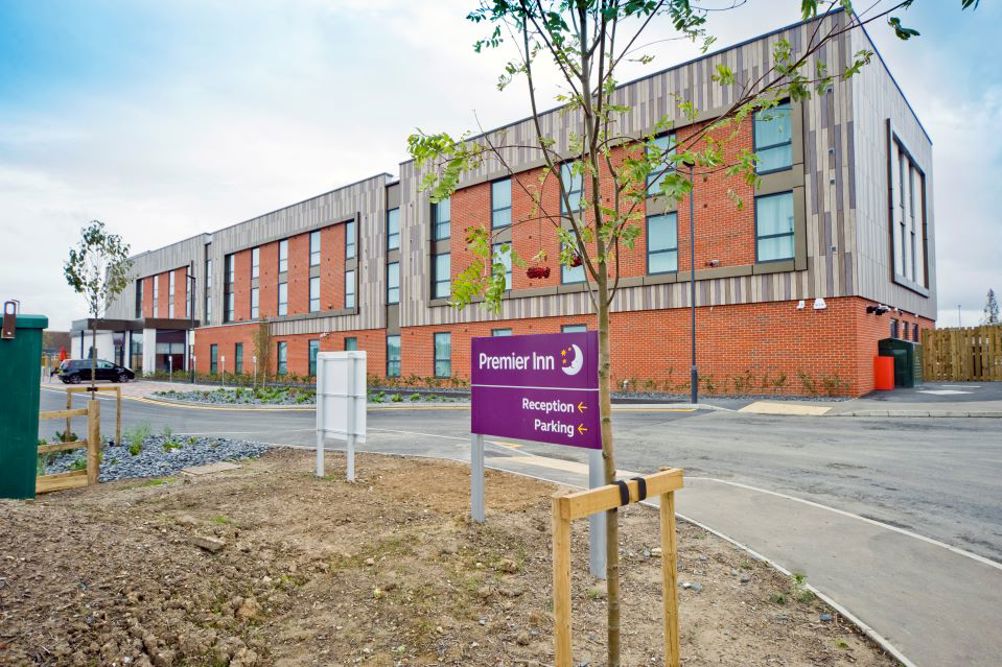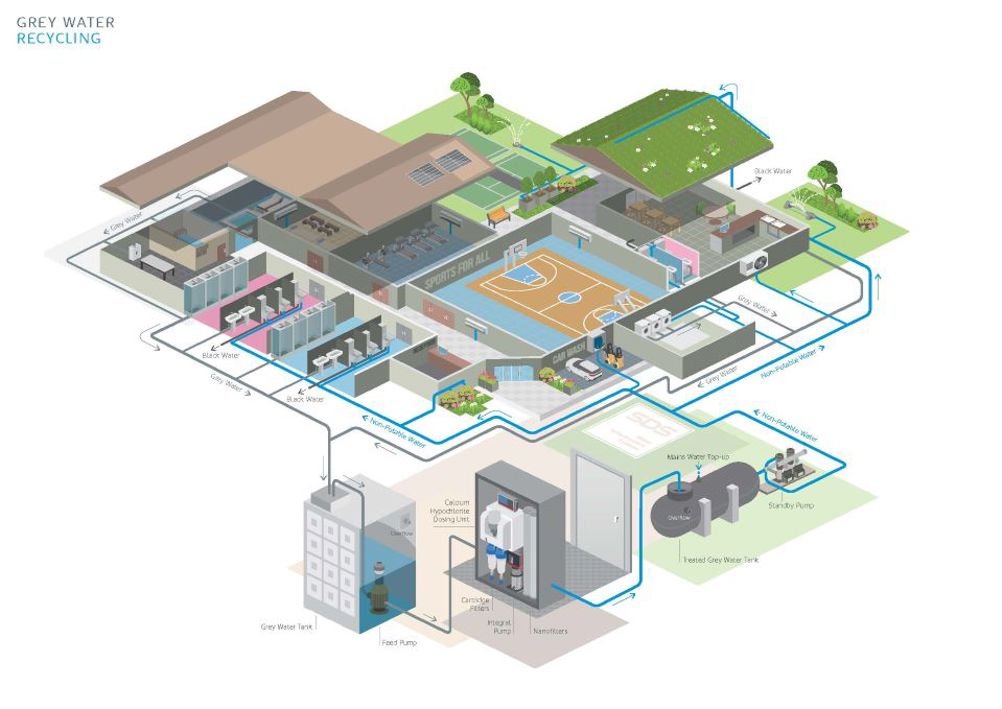Wasting water should be as socially unacceptable as blowing smoke in the face of a baby. That was the urgent appeal of Environment Agency chief executive Sir James Bevan in his famous “jaws of death” speech in 2019.1
Despite that warning, England is still on a trajectory to start running out of treated mains water within 20 years. By 2050, the deficit is predicted to reach 3,500 million litres per day. And yet, we flush a third of our high-quality mains water down our toilets at home every day. That’s before we even consider that up to 60%2 of the drinking water supplied to commercial buildings, such as office blocks or hotels, is used where high-level treatment is simply not needed.
We are staring climate change in the face. The extremes of drought and heavy rainfall are already commonplace weather patterns. It’s an emergency that demands an imperative response: reduce personal water demand from the current 140 litres per day average. In 2019, Sir James Bevan said he believed a daily limit of 100 litres per person is possible by 2050; Denmark has already achieved 80 litres. If we reduced per capita consumption to 100 litres per day and leakage by 50%, and did nothing else, there would be enough water for an additional 20 million people. We can do it, he said.
Water UK – the body that represents Water Companies – has told the Government that a maximum 2050 target of 85 litres per person per day is feasible by 20503. But how? There’s no silver bullet. A mix of water efficiency policies and incentives are needed to meet even the more modest 110 litres per person by 2050 target set by the National Framework for Water Resources.
Current planning regulations for England and Wales require a 125 litres per person daily limit, but the Environment Secretary George Eustice has said he will encourage local authorities in the 14 most water-stressed Water Company regions to adopt an optional 110 litres per person daily4. This lower limit is already applied through The London Plan, leading to much greater take-up of grey water schemes in new buildings in the capital.
Encouraging water to be reused in commercial, industrial and multi-occupancy residential buildings remains complex, requiring a mix of planning consents, cross-agency co-operation and favourable returns on investment.
Technology Advances
Greywater technologies have moved on to help meet these challenges. Therefore, better understanding and evidence of what they can achieve is essential to drive informed policy decision-making, as well as adoption by architects, engineers, developers and planners.
So, what greywater exactly can be recycled? It is usually wastewater harvested from baths, showers and handbasins, which is filtered, treated and then reused for non-drinking purposes such as toilet flushing, laundry or garden irrigation. Greywater systems are best suited for installation in new buildings because a separate network of additional pipework is required through the building.
Of course, any technology must first demonstrate it is commercially viable, before its environmental benefits can be fully exploited. Advances in grey water technology using a new ‘on-demand’ process are providing a more responsive and cost-efficient process that makes the Return on Investment more favourable. The new technology is also offering early adopters of greywater systems the opportunity to replace legacy high-maintenance MBR systems with more efficient and cost-effective systems.
On-Demand Technology
SDS’s Grey Water Recycling systems are supplied as package treatment plants. The Grey Water Recycling Large Scale (LS) system uses a sequence of leading-edge disk filtration and ultrafiltration processes unique to the UK. In one of the first residential installations in the UK, this system was successfully installed in a high-class apartment development in Holland Park, Kensington, one of London’s most exclusive addresses. Despite the extremely high-specification bathrooms, the building’s water usage was calculated to reduce by at least 15% to an average of 90 litres per person per day, more than meeting the planning requirements.
While the Holland Park development is one of the first residential buildings to use the new technology, it is also being adopted in new commercial, and mixed-use developments in London. SDS is also seeing take-up of the technology in hotels both in, and outside of, the capital. The same on-demand technology is already operating successfully internationally - in Europe including several sites in Spain, as well as in Mexico and the Middle East.
In 2022, SDS also launched a ground-breaking, smaller scale rapid greywater treatment system that is especially suitable for buildings with lower usage, for example hotels with between 50 and 150 bedrooms. Its first installation has been completed at the new 84-bed Premier Inn development in Faversham, Kent.

In the past, Membrane Bioreactor (MBR) systems have been the technology of choice for greywater reuse, the smaller footprint of on-demand systems together with their ability to provide quality recycled water whenever needed, makes them capable of significantly-improved investment payback.
At the Holland Park development, limited space to house the water treatment plant was a key consideration for public health engineers, chapman bdsp, leading them to search for an alternative to MBR and specify the SDS system.
MBR systems use a biological treatment process and a flat membrane which filters water at a much lower pressure than the new on-demand technology. For example, the SDS Grey Water Recycling systems treat grey water at 1m3 per hour, compared to 0.5m3 a day for a traditional MBR reactor.
Because it can be so quickly replenished, only about a quarter of a day’s supply of treated water needs to be stored at any one time. So, an on-demand system requires a much smaller footprint and can be more easily scaled up to match an expansion in requested supply. The only way to expand an MBR system is to add more reactor tanks.
Because an on-demand system has a much quicker start-up and shut-down procedure compared to MBR, it can be easily switched off during periods of low demand, for example in a commercial building at the weekend. It can then be restarted immediately when required by the building services operator or a facilities management contractor.
Furthermore, as MBR systems depend on building up a biomass of live bacteria, if grey water is not used at a sufficient rate, the bacteria can die, stopping the treatment process. MBR systems need a coarse filter before water enters the first collection tank, which the on-demand system does not. The MBR membranes can clog, also leading to smells, and may require more frequent replacing. So MBR systems require more maintenance and, if they have to be shut down, then it would be necessary for the supplier or manufacturer to reintroduce the bacteria and recommission the biological operation before the system could be brought back into use.
How it works
In the SDS Grey Water Recycling LS system, wastewater from a building’s baths, showers and hand-basins is directed into a collection tank. A submersible macerator pump feeds the water at high pressure to a disc filter, which uses a patented process to pass water through a disc stack with a centrifugal action to remove particulates > 100 microns. The disc filter provides a highly-efficient filtration process which avoids clogging. An automatic self-cleaning backwash process periodically cleans the discs to keep the filter running at optimum efficiency.
In the second stage of the process, the water is fed to a state-of-the-art ultrafilter, which is packed with hollow polymer fibres which ensure all contaminates > 0.05 microns are consistently removed. This is small enough to include bacteria and viruses and achieve near-potable water quality. The ultrafiltration membranes are also automatically cleaned using pressurised air and water.
The addition of sodium hypochlorite for chlorination and oxidation is kept to a minimum throughout the fast-moving process, before the water is given a final dose to ensure high-quality water is ready for onward distribution around the building.
The complete system is supplied with a control cabinet and HMI screen. In addition, an SDS SYMBiotIC data-logging and uplink device enables values from a wide range of input sensors to be recorded and visualised with a cloud-based dashboard. Data collected could include flow rates, temperature and level information. Alarms can be set up to alert if the data goes outside of predetermined limits, so that any discrepancies or anomalies can be quickly identified for action. Remote monitoring of the on-demand system not only assists system maintenance by operators, but the SDS service team can also identify any requirement for maintenance visits in real time, so continued supply is assured.
The SDS Grey Water Recycling SS system is designed along very similar treatment principles, except that the two-stage treatment process uses cartridge filters followed by nanofiltration, and intelligent chlorine dosing using dry block calcium hypochlorite.
Rapid Payback with Low Maintenance
The SDS Grey Water Recycling systems can pay back in as little as seven years, although actual return on investment will depend on the size of the system and the local water company charges. The system continues to deliver reliable, treated water throughout a long design life with minimal maintenance.
A key study commissioned by Waterwise, and conducted by Ricardo,6 outlined the UK policy changes and incentives that could be implemented to maximise the potential of water reuse and help bridge the gap between supply and demand. Waterwise has said the savings could amount to 630 million litres a day by 2050. New greywater technologies can make a key contribution by helping developers and building operators to meet regulations while reducing their water bills.

Sources:
1. Speech by Sir James Bevan, Chief Executive of the Environment Agency Waterwise Conference, “Escaping the jaws of death: ensuring enough water in 2050”, 19 March 2019.
2. Thames Water: Non-Potable Water Reuse as a Demand Management Option for WRMP19.
3. Water UK, Response to Consultation on Reducing Personal Water Use, October 2019.
4. Rt Hon George Eustice MP Written Statement. “Reducing Demand for Water”, 1 July 2021.
5. Waterwise/Ricardo, “Identifying Policy Options for Incentivising Rainwater Harvesting and Grey Water Recycling Systems in the UK”, 4 September 2020.







